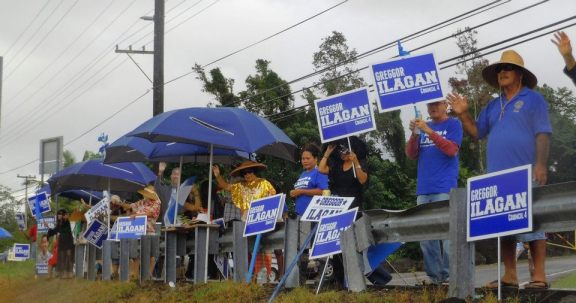If you’ve hit that after-work rush hour traffic on Highway 130, chances are you’ve seen the blue-T-shirt-wearing sign-wavers out there, rain or shine, driven by a commitment to support someone they believe in.
Or, perhaps you’ve been to the Maku’u Farmers Market recently and have seen the man himself, cheerfully shaking hands and “talking story” with market patrons.
Meeting Greggor Ilagan, the candidate running against incumbent Fred Blas for a seat on County Council District 4 in Puna, is pretty much inevitable at this stage in the game. Ilagan has been campaigning hard, and it has been paying off.
Ilagan’s background
After graduating from Waiakea High School in 2004, Ilagan promptly enlisted in the Air National Guard. For the years he was enlisted, Ilagan received the opportunity to travel the United States, but after six years of service, he came back to Hawaii to attend Hawaii Community College (HCC) to obtain a degree in accounting. Since moving back to the Big Island, he noticed that many of his high school friends went straight into schooling and had already received their degrees, but they were stuck on seemingly never-ending job hunts.
Ilagan was driven to run for council by a simple six word question he found himself wondering: “What was going to happen to me?”
Ilagan had been involved with the political processes of HCC, including the student government, student life council, and fee board, and he felt that representing District 4 could be a very real possibility.
“The county level was not representing very well… He [Fred Blas] was good at just organizing clean-ups, but not the type to think through things,” says Ilagan.
Funding his campaign
From January to early June, Ilagan and a team of supporters worked towards receiving Comprehensive Public Funding, a three-year pilot program funded by the Hawaii Election Campaign, to finance his campaign. The program requires that a minimum amount of qualifying contributions be earned for each candidate seeking funds, and qualifying contributions have to be made by check or money order, not cash.
Because Ilagan had a team pulling for him, he felt all the more motivated.
“We really took pride in it,” expresses Ilagan.
It took a good five months, but eventually the team achieved its goal. Comprehensive Public Funding provided him $16,320 for the primary base, and later, he received $5,103 for the general base, bringing his election total to $21,423.
Pressing issues in Puna
Ilagan believes that the biggest issue that District 4 faces is the layout of Highway 130, the highway that connects Kea’au to Pahoa and, as of now, the only route in and out of the area.
“There is nobody pushing because of a lack of funding,” says Ilagan.
Currently, there is a two-phase project to add two lanes to Highway 130 to lessen road congestion and ultimately improve driving conditions. The creation of the Kea’au-Pahoa Road Improvements Project was created in response to the projected 2020 traffic forecast and a recommendation made by The Hawaii Long-Range Land Transportation Plan, according to the official website.
Ilagan says that is a temporary solution.
Indeed, according to the Puna Community Development Plan published in 2008, the population is predicted to increase to 75,000 residents by 2030, over double the population of 31,335 in 2000.
“A real solution is to add an alternative route. It’s a hard battle to push for, but somebody has to get the ball rolling,” says Ilagan.

Sign-waving on Highway 130. Rain is not an issue for these enthusiastic supporters! Photograph c/o Greggor Ilagan
Communicating, addressing concerns
Of course, Highway 130 is just one of the concerns held by community members of district 4.
“I’m open to listening, understanding their needs, putting all the pieces together. I research when I’m not understanding something,” says Ilagan.
Ilagan has been actively using his Facebook account to stay connected with the Big Island community.
In addition to a Facebook profile that people can “friend,” Ilagan has a page where you can “like” him as a politician and inquire about his views and intentions if elected. Damon Tucker, a notable Big Island Blogger, posted on the politician’s wall, asking, “If elected, what would be the first bill you would try to pass?” To which Ilagan responded that his foremost move would be to review the new building code in hopes of making home ownership more affordable.
He has a presence on Facebook, while Blas does not. This incorporation of new media into his campaign could be a reflection of the age difference between the two candidates: Ilagan is 26 years old and Blas is 61 years old.
Although he maintains his online presence, Ilagan says he prefers to get out into the community to connect with people in person, noting that “the more personal the interaction, the better it is.” He has been traveling door-to-door, attending events at clubs and churches, going to board meetings, and setting up workshops, among other social events.
Change in Puna
Although he may not know it, Ilagan himself seems to be a symbol of change. He is bringing a fresh, young outlook to the politics of County Council.
“There’s a lot of generational change. District 1 termed out, district 2 termed out… A lot of new faces, and it changes the dynamic of the council,” says Ilagan. “We need a change. Puna hasn’t been given a chance to have a really big change.”

Leave a comment